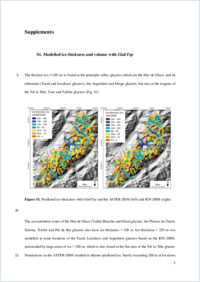Estimating glacier-bed overdeepenings as possible sites of future lakes in the de-glaciating Mont Blanc massif (Western European Alps)
- Magnin, F. Université Grenoble Alpes, Université Savoie Mont Blanc, CNRS, EDYTEM, 73000 Chambéry, France
- Haeberli, Wilfried Geography Department, University of Zurich, 8057 Zurich, Switzerland
- Linsbauer, Andreas Geography Department, University of Zurich, 8057 Zurich, Switzerland - Department of Geosciences, University of Fribourg, 1700 Fribourg, Switzerland
- Deline, P. Université Grenoble Alpes, Université Savoie Mont Blanc, CNRS, EDYTEM, 73000 Chambéry, France
- Ravanel, L. Université Grenoble Alpes, Université Savoie Mont Blanc, CNRS, EDYTEM, 73000 Chambéry, France
-
01.02.2020
Published in:
- Geomorphology. - 2020, vol. 350, p. 106913
English
De-glaciating high mountain areas result in new landscapes of bedrock and debris where permafrost can degrade, persist or even newly form in cases, and of new lakes in glacier bed overdeepenings (GBOs) becoming ice-free. These landscapes with new lakes in close neighborhood to over-steepened and perennially frozen slopes are prone to chain reaction processes (e.g. rock-ice avalanches into lakes triggering impact waves, dam breach or overtopping, and debris flows) with potentially far-reaching run-out distances causing valley floors devastation. The frequency, magnitude and zonation of hazards are shifting, requiring integrative approaches combining comprehensive information about landscape evolution and related processes to support stakeholders in their adaptation strategies. In this study, we intend to setup an essential baseline for such an integrative approach in the Mont Blanc massif (MBM), which is a typical high-mountain range affected by de-glaciation processes. We first (i) predict and (ii) detect potential GBOs by combining the GlabTop model with a visual analysis based on morphological indications of glacier flow through over- deepened bed parts. We then (iii) determine the level of confidence concerning the resulting information, and (iv) estimate the approximate time range under which potential lakes could form. The location of the predicted GBOs and the shape of glacier beds are evaluated against currently forming water bodies at retreating glacier snouts, and seismic and ice penetrating radar measurements on the Argentière glacier. This comparison shows that the location of predicted GBOs is quite robust whereas their morphometric characteristics (depth, volume) are highly uncertain and tend to be underestimated. In total, 48/80 of the predicted or detected GBOs have a high level of confidence. In addition to five recently formed water bodies at glacier snouts, one of the high confidence GBOs (Talèfre glacier) which is also the most voluminous one could form imminently (during coming years), if not partially or totally drained through deeply incised gorges at the rock threshold. Twelve other lakes could form within the first half of the century under a constant or accelerated scenario of continued glacier retreat. Some of them are located below high and permanently frozen rock walls prone to destabilization and high-energy mass movements, hinting at possible hot spots in terms of hazards in the coming decades, where more detailed analysis would be required.
- Faculty
- Faculté des sciences et de médecine
- Department
- Département de Géosciences
- Language
-
- English
- Classification
- Geology
- License
-
License undefined
- Identifiers
-
- RERO DOC 328529
- DOI 10.1016/j.geomorph.2019.106913
- Persistent URL
- https://folia.unifr.ch/unifr/documents/308695
Other files
Statistics
Document views: 157
File downloads:
- pdf: 229
- Supplementary material: 168

